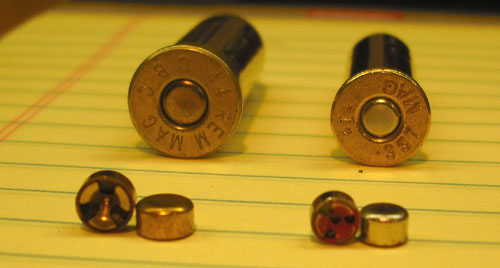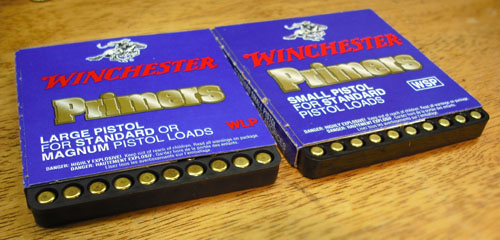“It all starts with the primer…”
Primers are small metal cups filled with high explosive compound. The primer is stuck by the hammer or firing pin, and when struck it ignites. When the primer ignites, it shootes a high intensity flame through the flash hole (hole between primer pocket and case interior) which ignites the powder charge. Primers are typically sold in packs of 100, or bricks of 1000 (10 packs of 100).
Pistol primers side by side: 44 magnum (large pistol primer) and 357 magnum (small pistol primer)

Pistol primer parameters
There are a few basic parameters that you need to evaluate when buying primers:
- Primer size (large, small)
Some cartridges require a large pistol primer (45acp, 44 special, 44 magnum, …) while others require a small pistol primer (9mm, 38 special, 357 magnum, …). Depending on what cartridge you are reloading, you need to buy the proper size primer for that application. - Primer type (Regular, Magnum, Multi-Purpose)
The type of primer indicates the overall intensity of the primer flame. Non-magnum loads (such as 38 special) only require a small flame to properly ignite the powder charge. Magnum loads require more activation energy since there is a lot more powder to burn. In some cases, a primer can be formulated to work with both regular and magnum loads (See WLP below). - Hardness
The hardness of the primer refers to the amount of force required to ignite the primer. Some primers are softer (Federal), some are harder (CCI typically), and some fall inbetween (Winchester). If your handgun has a lightened or modified trigger/action, you may need to use softer primers.
Winchester primers, WLP (Winchester Large Pistol – Multi-Purpose) and WSP (Winchester Small Pistol)

Next: Pistol Cartridge Basics
Originally published 01/2009

















































































